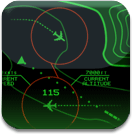We are in the early planning stages of a new Radar Chaos game, based on the Hawaiian Islands. While the current version is designed to assist beginners by offering a collection of newbie mazes, the Hawaii edition will be more a simulation than a game.
There are many, many things that must exist in a radar game before it can be regarded as a simulation. The list has no end. And no matter what you add, there will always be emails from users who want more. If you add enough realism, the game becomes unplayable for many, due to complexity. Finding this balance has been our primary struggle since creating our first simulation four years ago.
There are many features that we could add to Radar Chaos. Many have asked for hand offs, frequency assignments and visual approaches. While some of these features make it feel a little more ‘real’, they don’t build on the core challenge and fun aspect of the game. For example, in order to properly give a ‘hand off’, one must simply remember to do it. In order to properly give a frequency assignment, one must memorize frequencies. Giving a visual approach does not add to a game’s challenge either, as it is designed to relieve controller workload and reduce flying miles.
Is it even possible to develop a realistic air traffic control simulation for the home computer? Can you fit the most complex job in the world onto one screen? There are a couple of organizations that have taken radar realism farther than all others. However, the instructions are quite daunting for most people and, like the real world of air traffic control, it gets really boring at times. Our goal is to make games that capture what is truly stressful about the job, without a lot of instructions. In Airport Madness for example, players of all ages can manage a complex traffic situation just by a few mouse clicks. Is it like the real thing? Well, not exactly, but probably more fun!
This week Microsoft will launch their newest flight simulation, called ‘Flight’. While they have removed the word ‘simulator’ from the name, they insist that it is more than just a game. They have realized that their market could be larger by making the concept a little more ‘mainstream’. They don’t just want the aviation junkies anymore. They want everybody. While their software has always included worldwide scenery and 30 different aircraft types, Microsoft has figured out that most users aren’t interested in flying a Boeing 777 from Mumbai to London. The majority of players only fly the Cessna, never venturing too far from their home airport. Like us, they have figured out who their target audience must be. Let the hardcore flight simulation enthusiasts go and buy X-Plane. Most flight enthusiasts will likely use Microsoft Flight because of it’s simplicity.
Like Radar Chaos, Microsoft Flight will also be based on the Hawaiian Islands. This is a great idea. Why not specialize one one particular area and do it well, instead of giving users a thousand choices? Our Radar Chaos pipeline will likely bring a new location, such as San Francisco, in 2013. Each edition will evolve and improve upon the previous.

